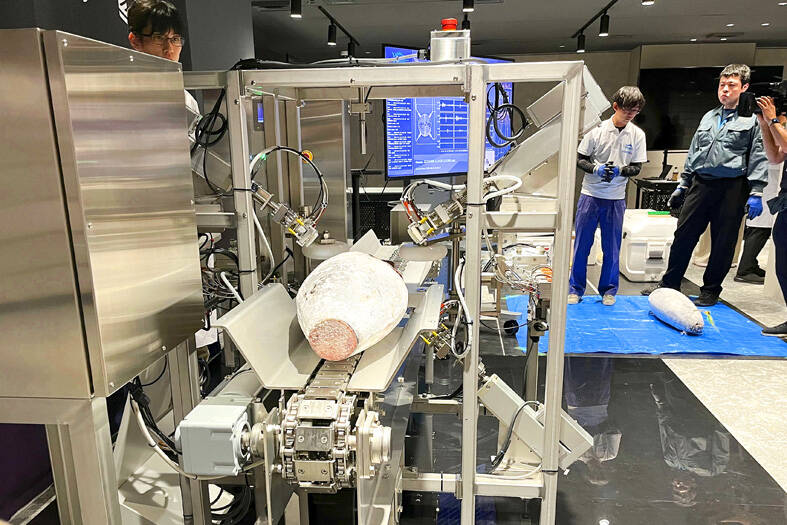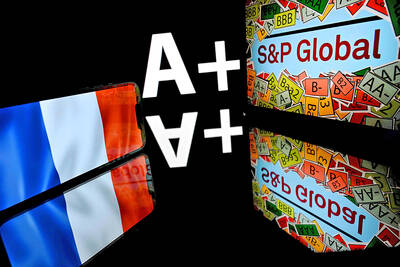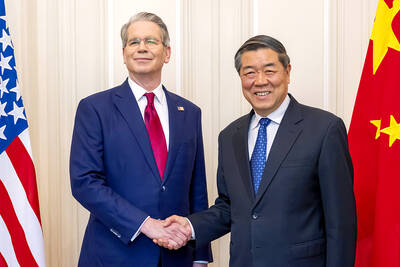Seafood lovers know the fatty marbling is what makes tuna sashimi and sushi so tasty, so for the industry, it is the fish’s level of fattiness that is used to judge its quality and pricing.
Usually, several people assess how fatty a tuna is by cutting the tail with a giant saw-like knife, an operation that takes about 60 seconds per fish.
However, now a machine called Sonofai uses ultrasound waves to do the job in 12 seconds, operated by a person without prior knowledge of how to carve fish.

Photo: AP
Fujitsu, the Japanese company behind the technology, invited reporters this week for a demonstration of Sonofai, a word blended from “sono” referring to “sound,” “f” for Fujitsu, and “ai,” or artificial intelligence. The name refers to its components but also stands for “son of AI.”
A conveyor belt transports a whole frozen tuna fish, about 1m in size, into a machine that beams ultrasound waves. Sensors pick up the waves to draw a zigzagging diagram on a screen to indicate the fish’s fattiness.
Fatty meat absorbs fewer sound waves than lean meat and AI sorts real data from misleading “noise,” or irregularities.
Hisashi Ishida, president of Sonofai, the start-up behind the technology, who also heads Ishida Tec Co, which makes food-manufacturing equipment, says it is safer, more sanitary and efficient.
“Fatty fish tastes good, feels better on your tongue and is called toro,” he said. “Overseas needs are growing, because sushi culture is now appreciated around the world.”
Beef has a grading system for fat and expected flavor, but being able to gauge the quality of tuna is new, said Hideto Okada, who oversees AI at Fujitsu.
Sonofai uses the same technology as medical ultrasound scans where high-frequency inaudible sound waves are absorbed or bounced back to create video-like images of things that are not visible, like a fetus inside a mother’s womb. Unlike the CT scan or X-ray, it does not use radiation, which can harm tissue.
Chris Edwards, a medical doctor and professor at Queensland University of Technology, who trains sonographers or healthcare professionals who specialize in ultrasound, has studied how ultrasound can be used to see the fattiness of a human liver, linked to diabetes and other health problems.
“They can look at one fish and compare it to another and say: ‘Oh, that one’s definitely got more fat than that one,’” he said.
However, Sonofai would not be at your neighborhood sushi chef.
Fish-processing outfits and fishing organizations are the likely buyers. The machine is set to go on sale in June for about ¥30 million (US$209,000) each, at first in Japan but expanding to the US and other places later. They would also work on upgrades to test for freshness, firmness and other characteristics of tuna and other fish varieties.

France cannot afford to ignore the third credit-rating reduction in less than a year, French Minister of Finance Roland Lescure said. “Three agencies have downgraded us and we can’t ignore this cloud,” he told Franceinfo on Saturday, speaking just hours after S&P lowered his country’s credit rating to “A+” from “AA-” in an unscheduled move. “Fundamentally, it’s an additional cloud to a weather forecast that was already pretty gray. It’s a call for lucidity and responsibility,” he said, adding that this is “a call to be serious.” The credit assessor’s move means France has lost its double-A rating at two of the

AI BOOST: Although Taiwan’s reliance on Chinese rare earth elements is limited, it could face indirect impacts from supply issues and price volatility, an economist said DBS Bank Ltd (星展銀行) has sharply raised its forecast for Taiwan’s economic growth this year to 5.6 percent, citing stronger-than-expected exports and investment linked to artificial intelligence (AI), as it said that the current momentum could peak soon. The acceleration of the global AI race has fueled a surge in Taiwan’s AI-related capital spending and exports of information and communications technology (ICT) products, which have been key drivers of growth this year. “We have revised our GDP forecast for Taiwan upward to 5.6 percent from 4 percent, an upgrade that mainly reflects stronger-than-expected AI-related exports and investment in the third

Mercuries Life Insurance Co (三商美邦人壽) shares surged to a seven-month high this week after local media reported that E.Sun Financial Holding Co (玉山金控) had outbid CTBC Financial Holding Co (中信金控) in the financially strained insurer’s ongoing sale process. Shares of the mid-sized life insurer climbed 5.8 percent this week to NT$6.72, extending a nearly 18 percent rally over the past month, as investors bet on the likelihood of an impending takeover. The final round of bidding closed on Thursday, marking a critical step in the 32-year-old insurer’s search for a buyer after years of struggling to meet capital adequacy requirements. Local media reports

RARE EARTHS: The call between the US Treasury Secretary and his Chinese counterpart came as Washington sought to rally G7 partners in response to China’s export controls China and the US on Saturday agreed to conduct another round of trade negotiations in the coming week, as the world’s two biggest economies seek to avoid another damaging tit-for-tat tariff battle. Beijing last week announced sweeping controls on the critical rare earths industry, prompting US President Donald Trump to threaten 100 percent tariffs on imports from China in retaliation. Trump had also threatened to cancel his expected meeting with Chinese President Xi Jinping (習近平) in South Korea later this month on the sidelines of the APEC summit. In the latest indication of efforts to resolve their dispute, Chinese state media reported that